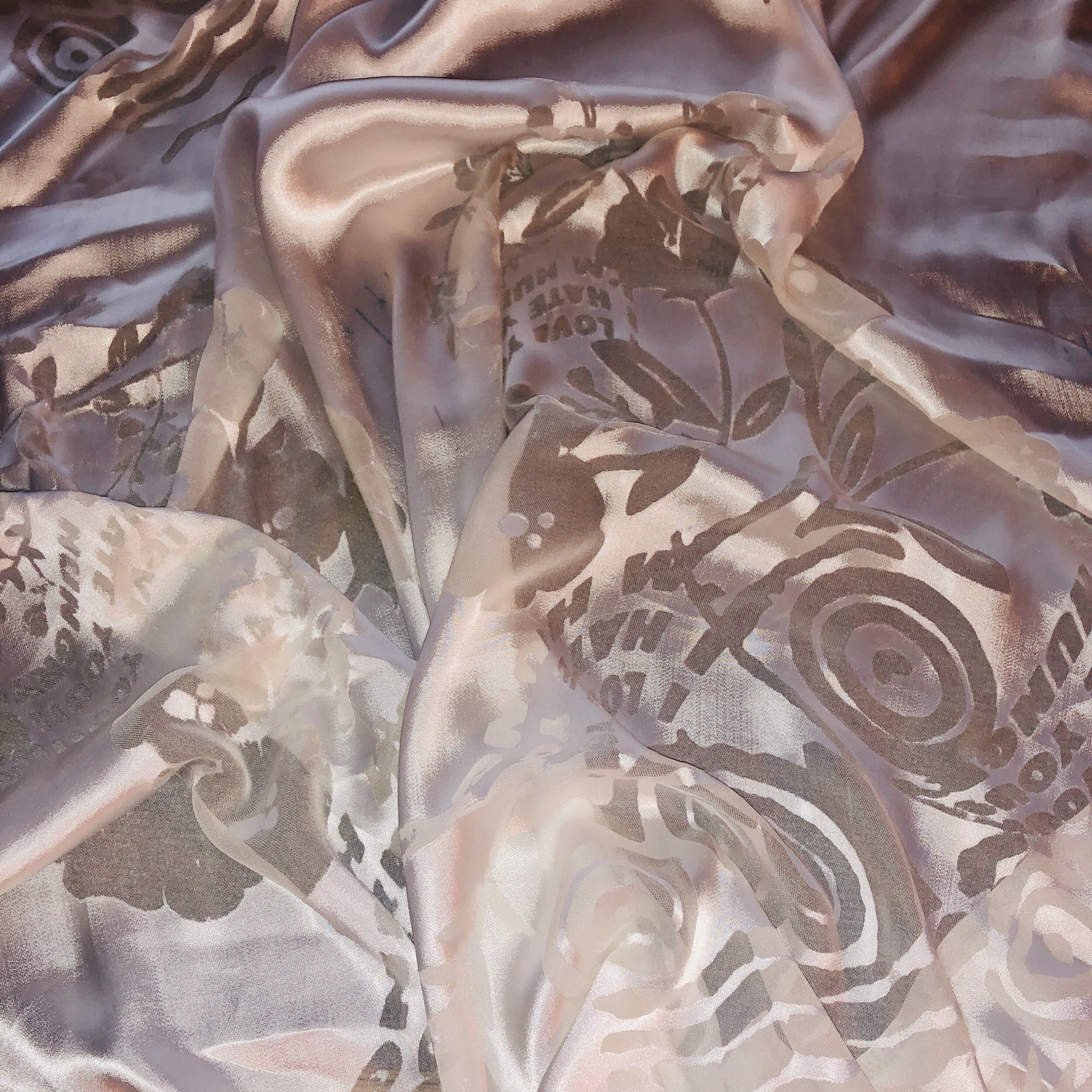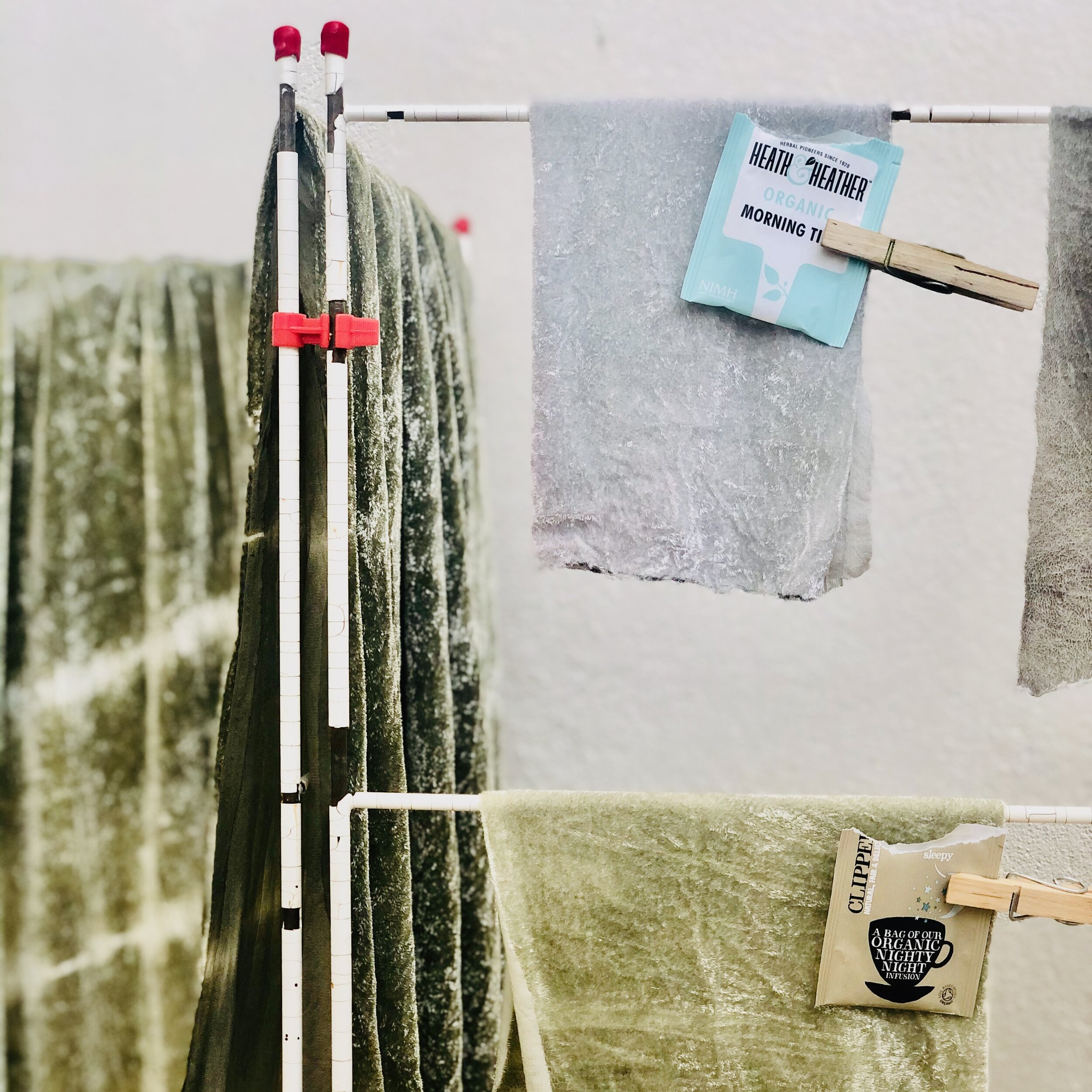“I found in the pieces eludes the documentary; slips into a silence that is eloquent if you can read its messages. I like the presence of absence, the holes left by stitches, the impressions and the corrosions and the challenge of unpacking incomplete, incoherent remains... Death’s ‘simultaneous mouth’ is one that speaks and is silent through these textile remains, elucidating ‘recurring bodies’ as they pass through histories, causing, ceasing, eliciting emotions, both the felt ‘inner’ and the materialized ‘outer.’ Poetry synthesizes emotional thought into text like funerary rites transform emotional actions into materiality. The questions these archaeological cemetery textiles raised are the immaterial warp in their material gaps.”
Shrouds & Weeds
Soft Sculpture, Funerary Achievements, Weavings, Velvet
velvet devoré (meaning to devour), a chemical process, activated by heat, “eats” at the rayon fibers making up the velvet pile, leaving only the silk backing, creating transparent gaps in the velvet. Velvet has a rich and diverse history, a constellation of techniques, origins, methods and histories, but always a cloth linked to royalty, religion and luxury, using a textile with this specific material history is important for my “URquestion” (where is goth in globalization?), the patterns I etch in the cloth are inspired by illustrations from childhood books, migrations of textile designs across time and place, bears, clowns, queer desire, and the hangover left after the end of the millennium—gothic melancholy. An anachronicity, soft blasphemy… there is so much occult matters pressed into the folds of… velvet... loser necromancies... strange encounters... twilight zones, my work commingled and co-contaminated...fluid mediums. This form of elegiac poetics—imagined funerals, dirge-core, flag dances, poor revenants: I think through this material as a collection of markers, commemorative matter—an archive.
“The magic of cloth, I came to believe, is that it receives us: receives our smells, our sweat, our shape even. And when our parents, our friends, our lovers die, the clothes in their closets still hang there, holding their gestures, both reassuring and terrifying, touching the living with the dead—but for me, more reassuring than terrifying, although I have felt both emotions.”
About Dyeing
Out & Out Camouflage
Total Bloodbath
“...uniforms produced to delineate national allegiance, through recomposition, traversed national boundaries, and in all likelihood, that between friend and foe. Such unknowable connection between individual bodies had previously been commented upon in terms of class or race... intended to induce a frisson of revulsion ... wearing the ‘reincarnated’ cloth of dead comrades, or indeed, that of the enemy, was a distinct possibility. Yet herein lies the possibility of a different reading, one founded on a comfort in common threads perhaps, or a delight in the albeit temporary confusion of the signifying power of uniform that fragmentation through grinding brings about... the disassociated formlessness of dust and the new beginnings possible through disintegration, when things return to their ‘true indiscriminable character.”
I seek out an array of funereal objects—shrouds repeated in devoré velvet, handwoven flags, chainmail veils imbedded with coded language. These textiles recall both traditional craft methodologies of funeral rituals while referencing digital memorial practices. Along with semaphoric movements, videos, translations and self-dance compiles and de-files an accretion of signals.
Encoded Textiles
I code switch between discreet soundscapes of poetry & code-patterns of weavings, trans-translating to corrupt and create new meanings, as well as working through the more recognizable “SOS” Morse-signal. I see these works and my practice thematically linked to a framework of craft methods, queer amateurship and material studies through a gothic poetics of disidentification, a seesaw between final revelations and what is occulted.
“Frustrated by the categorizations and the catalogues of an art world still framed in terms of originators and originals, creative moments and authoritative claims, the digital zone appealed to her. The pixeled windows caught her eye. She had never been able to accept the boundaries between senses, the blueprints of authenticity to which her work was supposed to live up. Cameras had given her the chance to explore the technical potential of imaging machines, but she wanted her pictures to dance and scream, taste and smell, touch and contact senses still to come.”
Interweaving the gothic and queer forces me to confront research and practice asynchronously, not only to stitch together the work as I produce, but also stitching together over time and social space, and looking at the potentiality for processes to either be accessed, revived, archived, or deleted, written off, dusted.
“Coders and weavers alike know the frustration of repeatedly attempting to build something new, as well as the satisfaction of seeing little bits of thread or code come together— materialize—in exactly the right way”






























